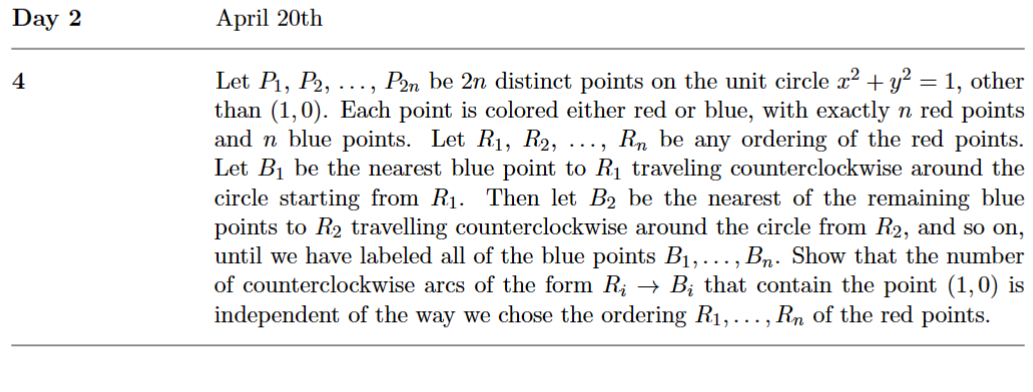2017年USAMO 真题:
Day 1
Note: For any geometry problem whose statement begins with an asterisk (![]() ), the first page of the solution must be a large, in-scale, clearly labeled diagram. Failure to meet this requirement will result in an automatic 1-point deduction.
), the first page of the solution must be a large, in-scale, clearly labeled diagram. Failure to meet this requirement will result in an automatic 1-point deduction.
Problem 1
Prove that there are infinitely many distinct pairs ![]() of relatively prime positive integers
of relatively prime positive integers ![]() and
and ![]() such that
such that ![]() is divisible by
is divisible by ![]()
Problem 2
Let ![]() be a collection of
be a collection of ![]() positive integers, not necessarily distinct. For any sequence of integers
positive integers, not necessarily distinct. For any sequence of integers ![]() and any permutation
and any permutation ![]() of
of ![]() , define an
, define an ![]() -inversion of
-inversion of ![]() to be a pair of entries
to be a pair of entries ![]() with
with ![]() for which one of the following conditions holds:
for which one of the following conditions holds:![]()
![]() or
or![]() Show that, for any two sequences of integers
Show that, for any two sequences of integers ![]() and
and ![]() , and for any positive integer
, and for any positive integer ![]() , the number of permutations of
, the number of permutations of ![]() having exactly
having exactly ![]()
![]() -inversions is equal to the number of permutations of
-inversions is equal to the number of permutations of ![]() having exactly
having exactly ![]()
![]() -inversions.
-inversions.
Problem 3
(![]() ) Let
) Let ![]() be a scalene triangle with circumcircle
be a scalene triangle with circumcircle ![]() and incenter
and incenter ![]() . Ray
. Ray ![]() meets
meets ![]() at
at ![]() and meets
and meets ![]() again at
again at ![]() ; the circle with diameter
; the circle with diameter ![]() cuts
cuts ![]() again at
again at ![]() . Lines
. Lines ![]() and
and ![]() meet at
meet at ![]() , and
, and ![]() is the midpoint of
is the midpoint of ![]() . The circumcircles of
. The circumcircles of ![]() and
and ![]() intersect at points
intersect at points ![]() and
and ![]() . Prove that
. Prove that ![]() passes through the midpoint of either
passes through the midpoint of either ![]() or
or ![]() .
.
Day 2
Note: For any geometry problem whose statement begins with an asterisk (![]() ), the first page of the solution must be a large, in-scale, clearly labeled diagram. Failure to meet this requirement will result in an automatic 1-point deduction.
), the first page of the solution must be a large, in-scale, clearly labeled diagram. Failure to meet this requirement will result in an automatic 1-point deduction.
Problem 4
Let ![]() ,
, ![]() ,
, ![]() ,
, ![]() be
be ![]() distinct points on the unit circle
distinct points on the unit circle ![]() , other than
, other than ![]() . Each point is colored either red or blue, with exactly
. Each point is colored either red or blue, with exactly ![]() red points and
red points and ![]() blue points. Let
blue points. Let ![]() ,
, ![]() ,
, ![]() ,
, ![]() be any ordering of the red points. Let
be any ordering of the red points. Let ![]() be the nearest blue point to
be the nearest blue point to ![]() traveling counterclockwise around the circle starting from
traveling counterclockwise around the circle starting from ![]() . Then let
. Then let ![]() be the nearest of the remaining blue points to
be the nearest of the remaining blue points to ![]() travelling counterclockwise around the circle from
travelling counterclockwise around the circle from ![]() , and so on, until we have labeled all of the blue points
, and so on, until we have labeled all of the blue points ![]() . Show that the number of counterclockwise arcs of the form
. Show that the number of counterclockwise arcs of the form ![]() that contain the point
that contain the point ![]() is independent of the way we chose the ordering
is independent of the way we chose the ordering ![]() of the red points.
of the red points.
以下是我们为您整理的真题试卷,扫码即可免费领取完整版:


更多USAMO 历年真题+真题详解
扫码添加顾问即可免费领取

